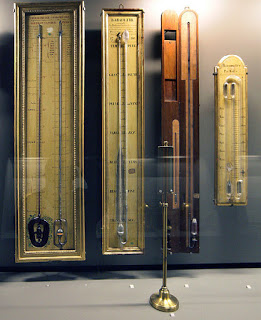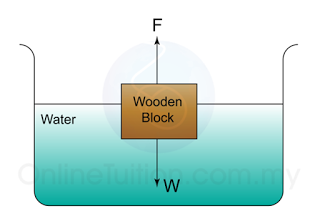
- The principle of floatation states that when an object floats in a liquid the buoyant force/upthrust that acts on the object is equal to the weight of the object.
- As shown in the figure above, if the weight of the object (W) = upthrust (F), the object is in balance and therefore float on the surface of the fluid.
- If the weight of the object > upthrust, the object will sink into the fluid.
Note
- Displaced volume of fluid = volume of the object that immerse in the fluid.
- If weight of the object > upthrust, the object will sink into the fluid.
- If weight of the object = upthrust, the object is in balance and therefore float on the surface of the fluid.
In order to solve the problem related to object immerse in water, it's important to know the all forces acted on the object.
Case 1:

- The density of the object is lower than the density of the liquid. The object floats on the surface of the water.
- The forces acting on the object is
- the weight of the object(W)
- the upthrust (F)
Case 2:
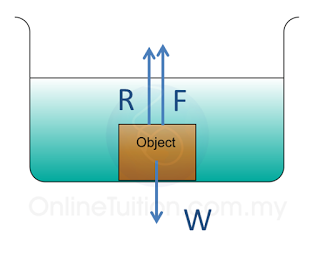
- The density of the object is greater than the density of the liquid. The object sink to the bottom of the water.
- Lying on the bottom of the water, there is a normal reaction acted on the object.
- The forces acting on the object is
- the weight of the object(W)
- the upthrust (F)
- Normal reaction (R)
Case 3:

- The density of the object is greater than the density of the liquid. The object is hold by a string so that it does not sink deeper into the water.
- The forces acting on the object is
- the weight of the object(W)
- the upthrust (F)
- Tension of the string (T)
Case 4:
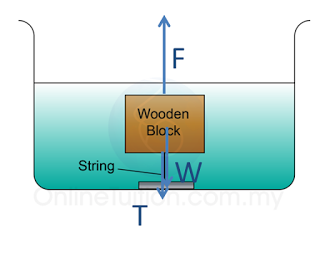
- The density of the object is lower than the density of the liquid. The object is hold by a string so that it does not move up to the surface of the water.
- The forces acting on the object is
- the weight of the object(W)
- the upthrust (F)
- Tension of the string (T)
F = W + T
Example 1:
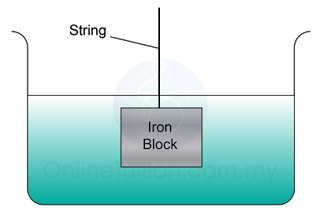
A metal block that has volume of 0.2 m³ is hanging in a water tank as shown in the figure to the left. What is the tension of the string? [ Density of the metal = 8 × 10³ kg/m³, density of water = 1 × 10³ kg/m³]
Answer:
Let,
Tension = T
Weight = W
Upthrust = F
Diagram below shows the 3 forces acted on the block.
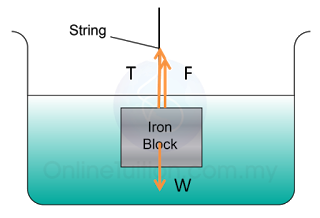
The 3 forces are in equilibrium, hence

Example 2:
A wooden sphere of density 0.9 g/cm³ and mass 180 g, is anchored by a string to a lead weight at the bottom of a vessel containing water. If the wooden sphere is completely immersed in water, find the tension in the string.
Answer:
Let's draw the diagram that illustrate the situation:

We need to determine the volume of the displaced water to find the upthrust.
Let the volume of the wooden sphere = V
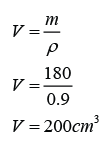
Let,
Tension = T
Weight = W
Upthrust = F
All the 3 forces are in equilibrium, hence

Example 3:
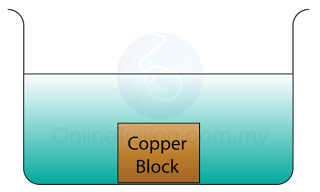
Figure above shows a copper block rest on the bottom of a vessel filled with water. Given that the volume of the block is 1000cm³. Find the normal reaction acted on the block.
[Density of water = 1000 kg/m³; Density of copper = 3100 kg/m³]
Answer:
Volume of the block, V = 1000cm³ = 0.001m³
Let,
Normal Reaction = R
Weight = W
Upthrust = F
Diagram below shows the 3 forces acted on the block.

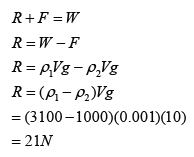
3.5.1 Archimedes Principle
- Archimedes Principle states that when a body is wholly or partially immersed in a fluid it experiences an upthrust equal to the weight of the fluid displaced.
- Upthrust/Buoyant force is an upward force exerted by a fluid on an object immersed in it.
- Mathematically, we write
ρ = Density of the liquid
V = Volume of the displaced liquid
g = Gravitational field strength
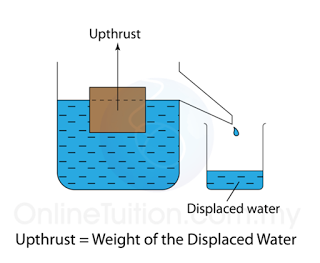
Determine the upthrust acted on the objects immerse in the water below.
a.

b.

c.

Answer:
a. Upthrust = Weight of the displaced water = 15N
b. Upthrust = Weight of the displaced water = 32N
c. Upthrust = Weight of the displaced water = 20N
Example 2:
An iron block which has volume 0.3m³ is immersed in water. Find the upthrust exerted on the block by the water. [Density of water = 1000 kg/m³]
Answer:
Density of water, ρ = 1000 kg/m³
Volume of water, V = 0.3 m³
Gravitational Field Strength, g = 10 N/kg
Upthrust, F = ?

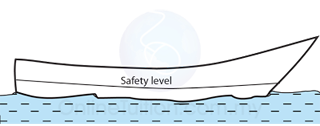
Figure above shows an empty boat floating at rest on water. Given that the mass of the boat is 150kg. Find
- the upthrust acting on the boat.
- The mass of the water displaced by the boat.
- The maximum mass that the boat can load safely if the volume of the boat at the safety level is 3.0 m³.
Answer:
a. According to the principle of flotation, the upthrust is equal to the weight of the boat.
Upthrust,
F = Weight of the boat
= mg = (150)(10) = 1500N
b. According to the Archimedes' Principle, the weight of the water displaced = Upthrust
Weight of the displaced water,
W = mg
(1500) = m(10)
m = 150kg
c.
Maximum weight can be sustained by the boat

Maximum weight of the load
= Maximum weight sustained - Weight of the boat
= 30,000 – 1,500 = 28,500N
Maximum mass of the load
= 28500/10 = 2850 kg
Example 4:
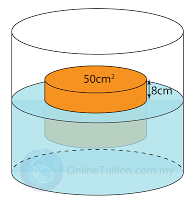
In figure above, a cylinder is immersed in water. If the height of the cylinder is 20cm, the density of the cylinder is 1200kg/m³ and the density of the liquid is 1000 kg/m³, find:
a. The weight of the object
b. The buoyant force
Answer:
a.
Volume of the cylinder, V = 50 x 20 = 1000cm³ = 0.001m³
Density of the cylinder, ρ = 1200 kg/m³
Gravitational Field Strength, g = 10 N/kg
Weight of the cylinder, W = ?

b.
Volume of the displaced water
= 50 x 12 = 600cm³ = 0.0006m³
Density of the water, ρ = 1000 kg/m³
Upthrust, F = ?

Example 5
The density and mass of a metal block are 5.0×103 kg m-3 and 4.0kg respectively. Find the upthrust that act on the metal block when it is fully immerse in water.
[ Density of water = 1000 kgm-3 ]
Answer:
In order to find the upthrust, we need to find the volume of the water displaced. Since the block is fully immersed in water, hence the volume of the water displaced = volume of the block.
Volume of the block,
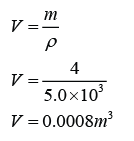
Upthrust acted on the block,

3.4.3 Hydraulic Braking System and Hydraulic Jack
Hydraulic Brake
In most vehicle, hydraulic system is used in the braking system, as shown in the figure below.
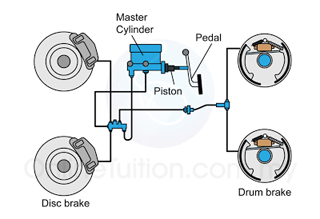
Usually, a disc brake is used in the front wheel of a car while a drum brake is used in the back wheel of a car.
Working Mechanism of Hydraulic Brake
- When the brake pedal is pressed, the piston of the master cylinder applies a pressure on the brake fluid.
- This pressure is transmitted uniformly to each cylinder at the wheel, cause the pistons at the wheels to push the brake shoes to press against the surface of the brake.
- The friction between the brakes and brake shoes causes the vehicle to slow down and stop.
Q & A
Q: Why is it dangerous if air bubble is trapped in the brake fluid of a braking system.A:
- If air bubble is present in the fluid, the fluid become compressible.
- This may prevent pressure transmits through the fluid and hence causing ineffective braking effect.
Q & A
Q: Why oil but not water is used as the hydraulic fluid in a hydraulic brake system?A:
- Because the boiling point of oil is much higher than water. This can prevent the hydraulic fluid from boiling when the brake is very hot.
- Water may cause rusting in the part of the braking system
Hydraulic Jack
Working mechanism of a hydraulic jack.
- When the handle is pressed down, valve A is closed whereas valve B is opened. The hydraulic fluid is forced into the large cylinder and hence pushes the piston moving upward.
-

- When the handle is raised, valve B will be closed while vale A will be opened. Hydraulic fluid from the buffer tank will be suck into the small cylinder.
-
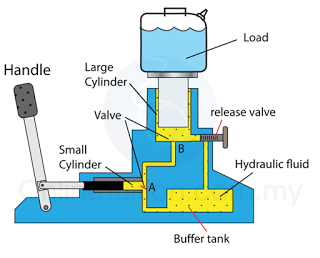
- This process is repeated until the load is sufficiently lifted up.
- The large piston can be lowered down by releasing the hydraulic fluid back to the buffer tank through the release vale.
3.4.2 Hydraulic System
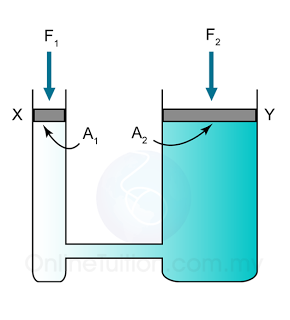
- A hydraulic system applies Pascal's principle in its working mechanism. It can be used as a force multiplier.
- In this hydraulic system, a small force, Fl is applied to the small piston X results in a large force, F2 at the large piston Y. The pressure, due to the force, F1, is transmitted by the liquid to the large piston.
- According to Pascal’s principle,
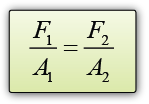
Change of Oil Level in a Hydraulic System
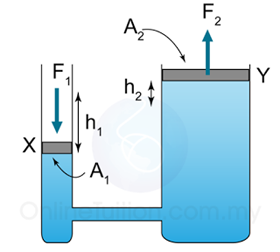
In the diagram to the left, when piston-X is pressed down, piston-Y will be push up. The change of the piston levels of the 2 pistons is given by the following equation:

In a hydraulic system the large piston has a cross-sectional area A2 = 200 cm² and the small piston has cross-sectional area A1 = 5 cm². If a force of 250 N is applied to the small piston, what is
a. the pressure exerted on the small piston
b. the force F, produced on the large piston?
Answer:
a. Pressure exerted on the small piston

b. Pressure exerted on the large piston = Pressure exerted on the small piston
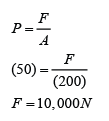
A hydraulic lift is to be used to lift a truck masses 5000 kg. If the diameter of the small piston and large piston of the lift is 5cm and 1 m respectively,
a. what gauge pressure in Pa must be applied to the oil?b. What is the magnitude of the force required on the small piston to lift the truck?
Answer:
a. Weight of the truck,
W = mg
W = (5000)(10) = 50,000N
Area of the big piston

Pressure of the oil

b.
Area of the small piston

According to the Pascal's Principle,
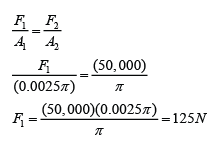
Example 3:

Figure above shows a hydraulic system. The area of surface X is 5 cm² and the area of surface Y is 100 cm². Piston X has been pushed down 10cm. what is the change of liquid level, h, at Piston Y?
Answer:
Distance move by the piston-X, h1 = 10cm
Distance move by the piston-Y, h2 = h
Area of piston-X, A1 = 5 cm²
Area of Piston-Y, A2 = 100 cm²
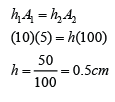
3.4.1 Pascal’s Principle
- Pascal's principle states that in a confined fluid, an externally applied pressure is transmitted uniformly in all directions.
- Pascal's principle is also known as the principle of transmission of pressure in a liquid.
Q & A
Q: Suggest an experiment to prove Pascal’s Principle.A:

- When the plunger is pushed in, the water squirts equally from all the holes.
- This shows that the pressure applied to the plunger has been transmitted uniformly throughout the water.
3.3.5 Applications of Atmospheric Pressure
Syringe
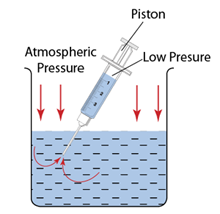
- When the piston is pulled up, the atmospheric pressure inside the cylinder will decrease.
- The atmospheric pressure outside pushes the liquid up into the syringe.
Lift Pump
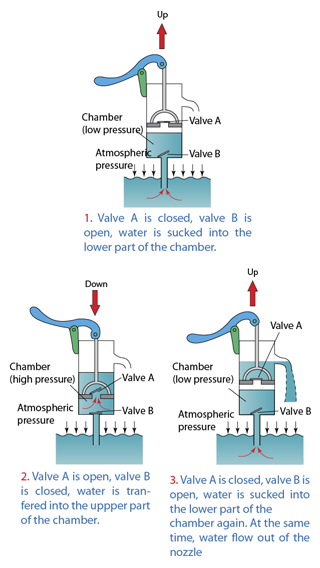
Siphon
Working Mechanism of Siphon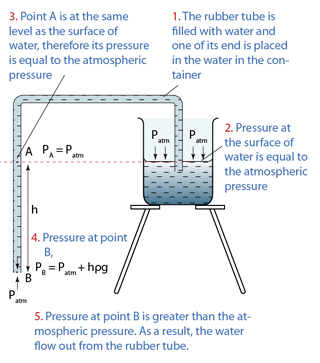
Sucker Hook
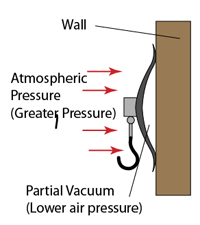
When the sucker is pressed into place, the air inside is forced out. As a result, the pressure inside the sucker become very low. The sucker is then held in position by the high atmospheric
pressure on the outside surface.
Straw
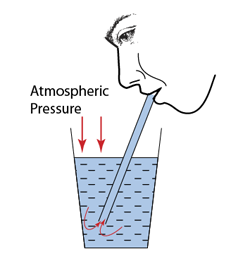
When a person sucks through the straw, the pressure in the straw become low. The atmospheric pressure outside which is higher will force the water into the straw and consequently into the mouth.
Rubber Sucker
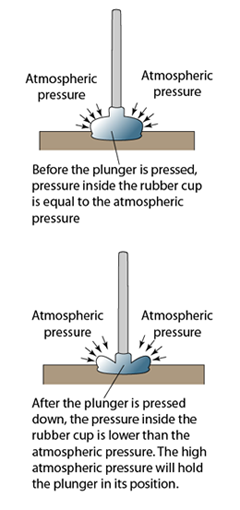
Vacuum Cleaner
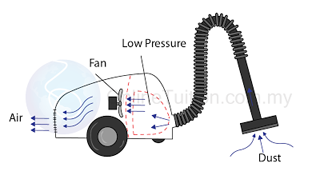
3.3.4 Measuring Atmospheric Pressure
- Atmospheric pressure can be measured by either
- a simple barometer,
- a Fortin barometer
- an Aneroid barometer.
- In SPM, most of the questions asked are related to the simple barometer.
- For Fortin barometer and Aneroid barometer, you only need to know their working principle.
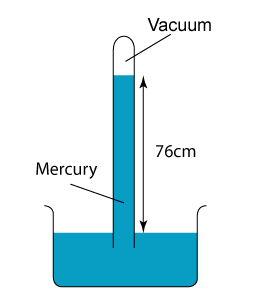
Simple Mercury Barometer
This image is created by Edal Anton Lefterov and shared under the Creative Commons Attribution-Share Alike 3.0 Unported license. |

Aneroid Barometer
Simple Barometer

- Atmospheric pressure can be measured by a simple barometer.
- A thick glass tube (at least 1m long) is filled with mercury completely.
- The open end of the tube is covered with a finger and inverted in a trough of mercury.
- The height of the mercury is proportional to the atmospheric pressure.
Using Simple Mercury Barometer
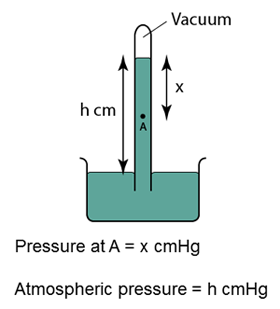
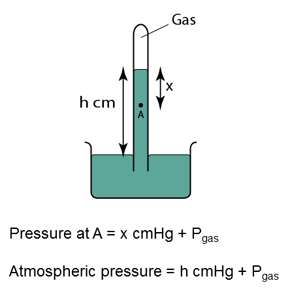
Characteristics of the Mercury Barometer
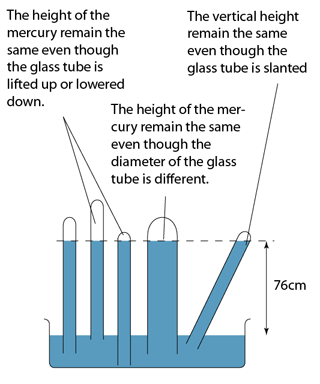
Q: Barometer is usually made up of mercury. Explain why is it not practical to have a water barometer?
A:
- The atmospheric pressure is about 10 meter water, which means it can push the water up to 10 meter height.
- Therefore a water barometer must be at least 10 meter long.
- This is not practical because the glass tube of the barometer may be broken or topple easily. It is also difficult to keep or move such a long tube.
Fortin Barometer
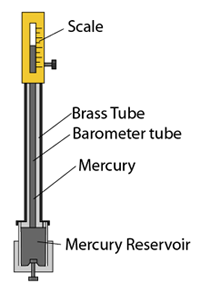
- The Fortin barometer is an improved version of the simple mercury barometer.
- The barometer tube is encased in a brass frame. This enables it to be carried around easily.
- Vernier scale is used for taking reading for extra accuracy.
Q & A
Q: What is the advantages of a Fortin Barometer over a Simple mercury barometer?A:
- Easy to be carried around.
- More accurate.
Anaroid Barometer

The anaroid barometer is usually used to measure altitude, which is named as altimeter.
Q & A
Q: Explain why the barometer can be used to measure altitude.A:
The atmospheric pressure is inversely proportional to the altitude. The altitude can be determined from the atmospheric pressure.
Q & A
Q: Why a simple barometer is not suitable to be used to measure altitude?A:
- Hard to be carried
- Mercury is volatile. It can evaporate easily
- Mercury is poisonous
Converting the Unit from cmHg to Pa
Pressure in unit cmHg can be converted to Pa by using the formula
Find the pressure at point A, B, C, D, D, E and F in the unit of cmHg and Pa. [Density of mercury = 13600 kg/m³]
Answer:
| Pressure in unit cmHg | Pressure in unit Pa |
|---|---|
| PA = 0 PB = 17 cmHg PC = 17 + 59 = 76 cmHg PD = 76 + 8 = 84 cmHg PE = 76 cmHg PF = 76 cmHg |
PA = 0 PB = hρg = (0.17)(13600)(10) = 23,120 Pa PC = hρg = (0.76)(13600)(10) = 103,360 Pa PD = hρg = (0.84)(13600)(10) = 114,240 Pa PE = hρg = (0.76)(13600)(10) = 103,360 Pa PF = hρg = (0.76)(13600)(10) = 103,360 Pa |

Figure above shows a simple mercury barometer. What is the value of the atmospheric pressure shown by the barometer? [Density of mercury = 13600 kg/m³]
Answer:
Atmospheric Pressure,
P = 76 cmHg
or
P = hρg = (0.76)(13600)(10) = 103360 Pa

In above, the height of a mercury barometer is h when the atmospheric pressure is 101 000 Pa.
What is the pressure at X?
Answer:
Atmospheric Pressure,
Patm = h cmHg = 101 000 Pa
Pressure at X,
PX = (h - ¼h) = ¾h cmHg
PX = ¾ x 101 000 = 75 750 Pa

Figure above shows a mercury barometer whereby the atmospheric pressure is 760 mm Hg on a particular day. Determine the pressure at point
a. A,
b. B,
c. C.
[Density of Mercury = 13 600 kg/m³]
Answer:
a.
b.
c.

Figure above shows a simple barometer, with some air trapped in the tube. Given that the atmospheric pressure is equal to 101000 Pa, find the pressure of the trapped gas. [Density of Mercury = 13 600 kg/m³]
Answer:
Pressure of the air = Pair
Atmospheric pressure = Patm
Pair + 55 cmHg = Patm
Pair
= Patm - 55 cmHg
= 101 000 - (0.55)(13 600)(10)
= 101 000 - 74 800
= 26 200 Pa
If the atmospheric pressure in a housing area is 100 000 Pa, what is the magnitude of the force exerted by the atmospheric gas on a flat horizontal roof of dimensions 5m × 4m?
Answer:
Area of the roof = 5 x 4 = 20 m²
Force acted on the roof
F = PA
F = (100 000)(20)
F = 2,000,000 N
Example 7:
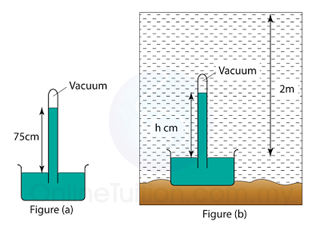
Find the vertical height (h) of the mercury in the barometer in the water. Given that the pressure at a depth of 10 m from the water surface is 75 cmHg. [Density of water = 1000 kg/m³, Density of mercury = 13 600 kg/m³]
Answer:
Atmospheric pressure,
Patm = 75 cmHg
Pressure caused by the water,
Pwater = 2/10 x 75 = 15cmHg
Pressure in 2m under water
= 75 + 15 = 90 cmHg
Vertical height of the mercury = 90cm
3.3.3 Measuring Gas Pressure
Instruments Used to Measure Gas Pressure
- The pressure of the gas in a container can be measured by using
- Bourdon gauge
- Manometer
- In SPM, almost all calculation question about using instruments to find gas pressure in a container are related to manometer. Therefore it's important for you to know the concept behind this instrument.
- For the Bourdon Gauge, you need to know its working mechanism.
Bourdon Gauge
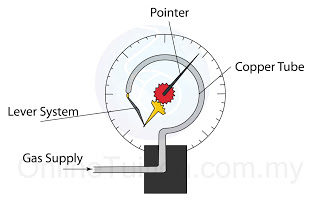
- A Bourdon gauge is used to measure to gas pressure in a container.
- There are 3 important components in a Bourdon gauge
- the copper tube
- the lever system
- the pointer
Working Mechanism of a Bourdon Gauge
- When the gauge is connected to a gas supply, the gas pressure will straighten the copper tube.
- The copper tube exerts a force on the lever system and hence move the pointer. The movement of the copper tube is magnified by the lever system
- The pointer rotates and give a reading (in unit of Pascal).
Manometer
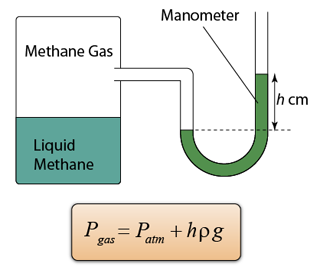
- A manometer is a U-shape tube filled with some liquid (usually mercury).
- Manometer is a device used to measure gas pressure in a container.
- The pressure of the gas is equal to the sum of the atmospheric pressure and pressure due to the column of liquid.
Note:
There are a few points we need to know when using a manometer- Difference in gas pressure at difference level can be ignored.
- Pressure on the surface of liquid is equal to the gas pressure in contact.
- Pressure that cause by liquid = hρg.
- For a given liquid, the pressures at any point of the same level are the same.
- For different liquid with different density, pressure at two different level will be different.
Example 1:

Figure above shows a manometer containing mercury connected to a tank with methane liquid and gas. Find the pressure of the gas supply in the units cmHg and Pa.
[Density of mercury = 13.6 x 10³ kg/m³; atmospheric pressure = 76 cmHg]
Answer:
Pressure of the gas in cmHg
P = 20 + 76 = 96 cmHg
Pressure of gas in Pa
The atmospheric pressure,

Pressure of the gas,

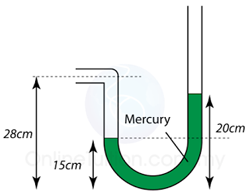
Figure above shows the mercury levels in a manometer used to measure the pressure of a gas supply. How much is the gas pressure greater than the atmospheric?
Answer:
- The pressure of the gas trapped in a capillary tube depends on the position of the tube.
- Figure below shows the pressure of the gas when the capillary tube is horizontal, vertical and vertically upside down.

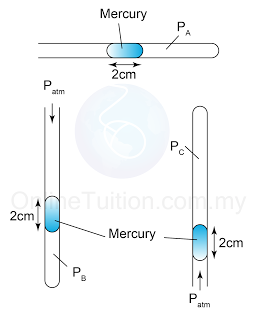
Figure above shows 3 identical capillary tubes with one end sealed and containing a column of mercury. PA, PB and PC are the gas pressure in the capillary tubes respectively. Find the value of PA, PB and PC. [Atmospheric pressure = 76cmHg]
Answer:
PA = 76cmHg
PB = 76cmHg + 2cmHg = 78cmHg
PC = 76cmHg - 2cmHg = 74cmHg
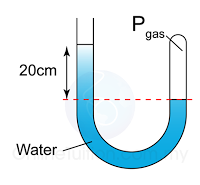
Figure above shows some air trapped in a J-tube. Find the pressure of the trapped air. [Density of water = 1000 kg/m³; Atmospheric pressure = 100,000 Pa]
Answer:

3.3.2 Atmospheric Pressure
- On the surface of the earth, there is a thick layer of gas called the atmosphere. The atmosphere consists of various types of gas called the atmospheric gas.
- The atmospheric gases collide on the surface of the earth and hence exert a pressure on the surface of the earth, called the atmospheric pressure.
- The atmospheric pressure can be measured in the unit of atm, mmHg or Pa. The atmospheric pressure at sea level is taken to be 1 atm, which is approximately 760 mmHg or 101,000 Pa.
Characteristics of Atmospherics Pressure
- Decreases with altitude
The atmospheric pressure changes accordingly to the altitude. Altitude is the height above sea level. The greater the altitude, the lower the atmospheric pressure. - Act equally in all direction
The atmospheric pressure acts on every object in the atmosphere. It acts equally in all direction. - Atmospheric pressure is ~ 100,000Pa at sea level
On the surface of the earth, the atmospheric pressure can be as high as 101,000 Pa.
Unit Used to Measure Atmospheric Pressure
- The following are the unit used to measure atmospheric pressure
- Pascal (Pa)
1 Pa = 1 N/m² - Standard Atmospheric Pressure (atm)
1 atm = Atmospheric Pressure at sea level ( = 101,325 Pa) - mmHg (also known as torr)
1 mmHg = 1/760 atm (roughly equal to the liquid pressure exerted by a millimetre of mercury). - milibar (Not used in SPM)
- Pascal (Pa)
- In SPM, usually we use the unit cmHg, instead of mmHg.
Proof of Existence of Atmospheric Pressure
The existence of the atmospheric pressure can be proved by the following experiments.- Crushing can experiment
- Water cover with cardboard does not flow out
- Magdeburg Hemisphere
Crushing Can Experiment
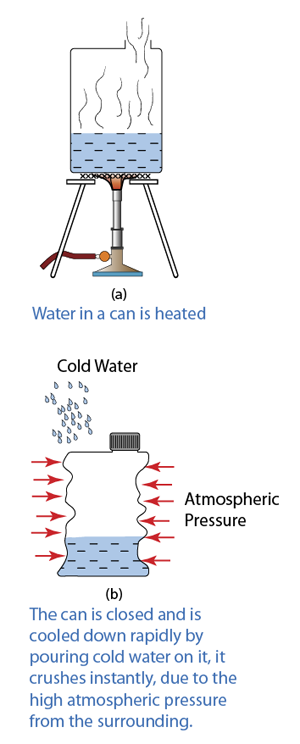
- When a can filled with hot water is closed and is cooled down rapidly by pouring cold water on it, it will crush instantly.
- This experiment proves that there is a huge atmospheric pressure exerts on everything on the surface of the earth.
Water cover with cardboard does not flow out

- The cardboard does not fall and the water remains in the glass even though it's not supported by anything.
- This is because the force caused by the atmospheric pressure acts on the surface of the cardboard is greater than the weight of the water in the glass. This experiment proves that atmospheric pressure is present on the surface of the earth.
Magdeburg Hemisphere

- When the air inside the hemisphere is pumped out so that it becomes a vacuum, the hemisphere cannot be separated even by a very great force.
- This is because when the air is pumped out, the pressure inside the hemisphere becomes very low.
- The atmospheric pressure exerts a strong force on the outer surface of the hemisphere, holding the hemisphere tightly together.
3.3.1 Gas Pressure
- Gas pressure is the force per unit area exerted by the gas molecules as they collide with the surface of an object.
- In SPM, especially in paper 2 essay question, you need to know how the gas pressure is produced. (See question below)
Explain how gas pressure is produced in a closed container?
Answer:
- Gas molecules in a container are in constant and random motion.
- As a result, the gas molecules collide on the wall of the container.
- After colliding on the wall, the gas molecules bounce off, and the direction change creating a change of momentum to the molecule of the gas.
- The change of momentum produces a force on the wall.
- The force per unit area is the pressure on the wall.

